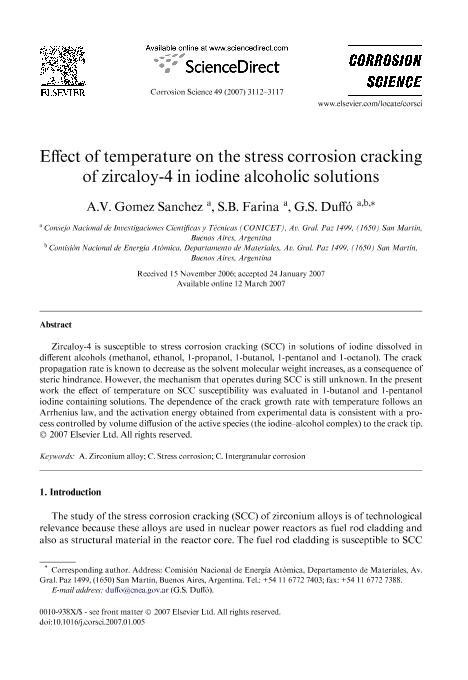Mostrar el registro sencillo del ítem
dc.contributor.author
Gomez Sanchez, Andrea Valeria

dc.contributor.author
Farina, Silvia Beatriz

dc.contributor.author
Duffó, Gustavo Sergio

dc.date.available
2019-02-06T22:45:30Z
dc.date.issued
2007-07
dc.identifier.citation
Gomez Sanchez, Andrea Valeria; Farina, Silvia Beatriz; Duffó, Gustavo Sergio; Effect of temperature on the stress corrosion cracking of zircaloy-4 in iodine alcoholic solutions; Pergamon-Elsevier Science Ltd; Corrosion Science; 49; 7; 7-2007; 3112-3117
dc.identifier.issn
0010-938X
dc.identifier.uri
http://hdl.handle.net/11336/69613
dc.description.abstract
Zircaloy-4 is susceptible to stress corrosion cracking (SCC) in solutions of iodine dissolved in different alcohols (methanol, ethanol, 1-propanol, 1-butanol, 1-pentanol and 1-octanol). The crack propagation rate is known to decrease as the solvent molecular weight increases, as a consequence of steric hindrance. However, the mechanism that operates during SCC is still unknown. In the present work the effect of temperature on SCC susceptibility was evaluated in 1-butanol and 1-pentanol iodine containing solutions. The dependence of the crack growth rate with temperature follows an Arrhenius law, and the activation energy obtained from experimental data is consistent with a process controlled by volume diffusion of the active species (the iodine-alcohol complex) to the crack tip.
dc.format
application/pdf
dc.language.iso
eng
dc.publisher
Pergamon-Elsevier Science Ltd

dc.rights
info:eu-repo/semantics/openAccess
dc.rights.uri
https://creativecommons.org/licenses/by-nc-sa/2.5/ar/
dc.subject
A. Zirconium Alloy
dc.subject
C. Intergranular Corrosion
dc.subject
C. Stress Corrosion
dc.subject.classification
Física Atómica, Molecular y Química

dc.subject.classification
Ciencias Físicas

dc.subject.classification
CIENCIAS NATURALES Y EXACTAS

dc.title
Effect of temperature on the stress corrosion cracking of zircaloy-4 in iodine alcoholic solutions
dc.type
info:eu-repo/semantics/article
dc.type
info:ar-repo/semantics/artículo
dc.type
info:eu-repo/semantics/publishedVersion
dc.date.updated
2019-02-05T14:13:26Z
dc.journal.volume
49
dc.journal.number
7
dc.journal.pagination
3112-3117
dc.journal.pais
Estados Unidos

dc.description.fil
Fil: Gomez Sanchez, Andrea Valeria. Consejo Nacional de Investigaciones Científicas y Técnicas. Centro Científico Tecnológico Conicet - Mar del Plata. Instituto de Investigaciones en Ciencia y Tecnología de Materiales. Universidad Nacional de Mar del Plata. Facultad de Ingeniería. Instituto de Investigaciones en Ciencia y Tecnología de Materiales; Argentina
dc.description.fil
Fil: Farina, Silvia Beatriz. Comisión Nacional de Energía Atómica. Gerencia del Área de Energía Nuclear. Unidad de Actividad de Materiales (CAC); Argentina. Consejo Nacional de Investigaciones Científicas y Técnicas; Argentina
dc.description.fil
Fil: Duffó, Gustavo Sergio. Comisión Nacional de Energía Atómica. Gerencia del Área de Energía Nuclear. Unidad de Actividad de Materiales (CAC); Argentina. Consejo Nacional de Investigaciones Científicas y Técnicas; Argentina
dc.journal.title
Corrosion Science

dc.relation.alternativeid
info:eu-repo/semantics/altIdentifier/doi/https://doi.org/10.1016/j.corsci.2007.01.005
dc.relation.alternativeid
info:eu-repo/semantics/altIdentifier/url/https://www.sciencedirect.com/science/article/pii/S0010938X07000212
Archivos asociados
